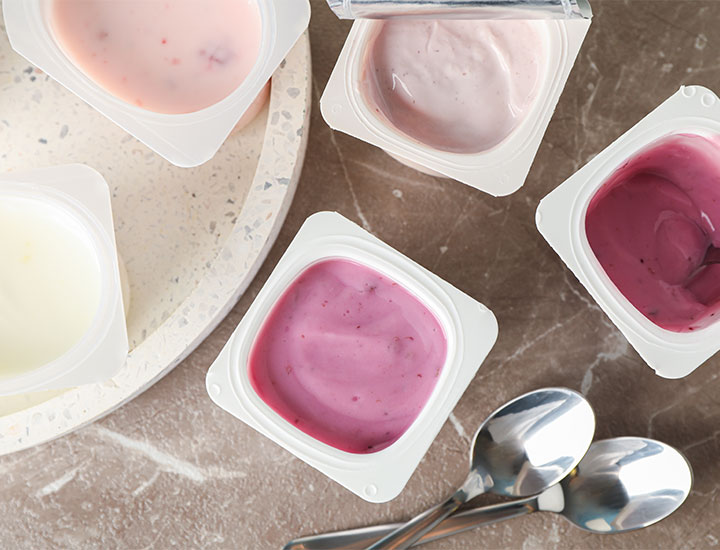
1. Flavored Yogurts
Plain Greek yogurt is high in protein, calcium, and a healthy dose of probiotics. It can also help keep healthy blood pressure and cholesterol levels. But, many yogurts today are made with added artificial sweeteners to increase their flavor.
Gillett, who owns her own private practice, Natalie Gillett Nutrition, LLC, explains, "Most flavored yogurts are loaded with sugar, some boasting up to 26 grams per 6 oz container—that's the max amount of sugar recommended in an entire day! Instead, opt for plain Greek yogurt and add fresh fruit or a touch of honey for natural sweetness." Berries are a metabolism-boosting fruit you can add to your yogurt for added sweetness.
Or, if you're not a fan of yogurt, Gillett recommends eating cottage cheese instead. This dairy even has more protein than yogurt! "Add fresh fruit, nut, and seeds to create a satisfying bowl," she says.
2. Granola
Even though granola is often thought to be a healthy breakfast meal, some popular brands actually have enough sugar to be considered a dessert. This is because granola often contains dried fruit, which is high in sugar. If you eat these types of granola too much, it could lead to weight gain and other health issues like insulin resistance.
Gillett explains, "Granola is a breakfast food that has a health halo around it—while it seems like it's healthy because it's made from oats, many varieties can actually be loaded with sugar and fat. Some brands contain up to 8 grams of sugar (that's 2 teaspoons) per measly ¼ cup!" But, that doesn't mean you need to cut granola completely out of your diet. She says to look for granola that "has less than 6 grams per serving and watch those portion sizes."
And, if you're looking for healthy fats with your breakfast to reduce inflammation, support gut health, and reduce visceral fat, Gillett recommends eating avocado on whole-grain toast. This meal is all the rage—and for good reason. "The healthy fats in avocado make this a great breakfast to start your day," she explains. "Not only are those fats healthy for your heart, but they also take a longer time to digest, keeping you full for longer."
3. Breakfast Bars
Similar to protein bars, m any breakfast bars are marketed as healthy but they actually lack the vitamins and minerals for a balanced meal. "Too much sugar, not enough fiber, and poor protein content leave some 'healthy breakfast bars' as nutritionally equivalent to a candy bar," Gillett says. "Try making your own breakfast bars at home using oats, chia seeds, nuts, and a controlled amount of sweetener."
If you're looking for a healthier option with fiber, she suggests eating peanut butter and jelly on whole wheat. "This kid's lunchtime class is actually one of my favorite breakfasts. It's quick, easy, and like avocados, nuts also contain healthy fats to keep you satisfied. Whole wheat bread provides some fiber to fill you as well," Gillett notes. Just be sure you're choosing peanut or other nut butters that aren't made with unnecessary sugar additives.
4. Smoothie Bowls
While smoothies and smoothie bowls can be a great way to combine ingredients you normally wouldn't eat (like spinach or cucumbers) into a tasty meal for weight loss, there are some downsides. "Smoothie bowls seem healthy because they're mostly made with fruits and veggies, but the problem is that they lack protein, which is essential to keeping you filled and fueled at the start of your day," Gillett warns. "Many of my clients who eat smoothie bowls report feeling hungry not too soon after eating them." Thankfully, you can make it a more filling meal by adding protein powder or stirring in plain Greek yogurt.
Smoothie bowls are also made with a variety of ingredients that can really add up to a bowl full of excessive calories. Some recipes call for as much as three or four pieces of fruit, large amounts of nuts, seeds, peanut butter, and avocado. So, you can end up with a bowl of sugar, fat, and calories—as much as 1,000 calories! While smoothie bowls can be healthy and tasty, make sure you're not overdoing it with large portions and high-calorie ingredients, and be sure to add protein to make it truly a more filling breakfast.
The Bottom Line
At the end of the day, a healthy breakfast that includes fiber, protein, and healthy fat has the potential to set you up for a day of great energy levels, stable blood sugar, and control over your appetite and weight. On the other hand, an unhealthy breakfast can leave you feeling sluggish, lead to weight gain, and could increase your risk of obesity-related diseases. To ensure you're making the right choices with your breakfasts, Gillett says it's always a good idea to check the label and look out for excessive, unhealthy additives.


